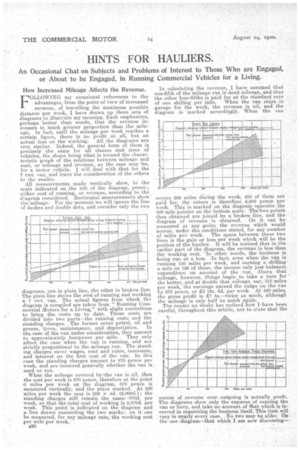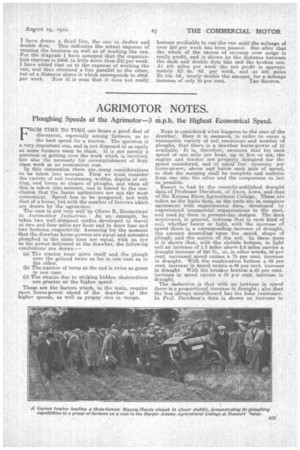HINTS FOR HAULIERS
Page 24

Page 25

If you've noticed an error in this article please click here to report it so we can fix it.
An Occasional Chat on Subjects and Problems of Interest to Those Who are Engaged, or About to be Engaged, in Running Commercial Vehicles for a Living.
How Increased Mileage Affects the Revenue. How Increased Mileage Affects the Revenue.
FOLLOWING my occasional references to the advantages, from the point of view of increased . revenue, of travelling the maximum possible distance per week, I have drawn up three sets of diagrams to illustrate my meaning. Each emphasizes, perhaps better than words, that the revenue increases in Much greater proportion than the mileage, In fact, until the mileage per Week reaches a certain figure, there is no profit at all, but an actual loss on the working. All the diagrams are very similar. Indeed, the general form of them is precisely the same for all classes and sizes of vehicles, the shape being what is termed the characteristic graph of the relations between mileage and cost, or mileage and revenue, as the case may -be, for a motor vehicle. I will deal with that for the 7 cwt. van, and leave the consideration of the others to the reader.
All measurements made vertically show, to the scale indicated on the left of the diagram, pence ; either cost of running, or revenue, .according to the diagram considered. Horizontal measurements show the mileage. For the moment we will ignore the line of dashes and double dots, and consider only the two diagrams, one in plain line, the other in broken line. The plain line shows the cost of running and working a 7 ()wt. -van. The actual figures from which the diagram is compiled are taken from "Thinning Commercial Motors for a Living," with slight corrections to bring the costs up to date.Those costs are divided into two parts—the running costs and the standing charges. The former cover petrol, oil and
grease, tyres, maintenance, and depreciation. In the case of the van under consideration, they amount to approximately fourpence per mile. They only affect the case when the van is running, and are strictly proportional to the mileage run. The standing charges cover wages, rent and rates, insurance, and interest on the first cost of • the van. In this case the standing charges amount to 870 pence per week, and are incurred generally whether the van is used or not.
When the mileage covered brthe van is nil, then the cost per week is 870 pence, therefore at the point 0 miles per week on the diagram, 870 pence is measured vertically, and the place marked. At 500 iniles per week the cost is 500 x 4d. (2,000d.) ; the standing charges still remain the same-870d. per week, so that the-total cost of working is 2,870d. per week. This point is indicated on the diagram and a line drawn connecting the two marks : on it can be measured, for any mileage rate, the working cost per mile per week.'
E30
In calculating the revenue, I have assumed that one-fifth of the mileage rim is dead mileage, and that the other four-fifths is paid for at the standard rate of one shilling per mile. When the van stays in garage for the week, the revenue is nil, and the diagram is marked accordingly. When the van covers 500 miles during the week, 400 of them are paid for, the return is therefore 4,800 pence per week. This is marked on the diagram opposite the 500 mile pointer on the bottom scale. Thelwo points thus obtained are joined by a broken line, and thediagram of revenue is obtained. On it can be measured at any point the revenue which would *accrue, under the conditions stated, for any number of miles per week. The space between these two lines is the gain or loss per week which will be the portion of the haulier. It will be noticed that in the earlier part of the diagram, the revenue is less than the working cost. In other words, the business is being run at a loss. Infact, even when the van is running 156 miles per week, and earning a shilling a mile on 125 of those, the income only just balances expenditure on account of the .van. Above that mileage, however, things begin to take a turn for the better, and at double that mileage, say, 310 miles per week, the earnings exceed the outgo on the van by 870 pence, or 23 12s. 6d. per week. At 460 miles, the gross profit is 27 5s.—twice as much, although the mileage is only half as mach again.
The reader no doubt has noticed how I have been careful, throughout this article, not to state that the I have drawn a third line, the one in dashes and double dots. This indicates the actual expense of running the business as well as of working the van. For the diagram I have assumed that the organization expense is 500d. (a little more than 22) per week. I have added that on to the expense of working the van, and thus obtained a line parallel to the other, but at a distance above it which corresponds to 500d. per week. Now it is seen that it does not really
become profitable to run the van until the mileage of over 250 per week has 'been passed. But after that the whole of the excess of revenue over outgo is really profit, and is Shown by the distance between the dash and double dots line and the broken one. At 400 miles per week the, net profit is approximately 23 6s. 8d, per week, and at 500 miles 25 16s. 8d., nearly double the amount, for a mileage
increase of only 25 per cent. THE SKOTCH.




























